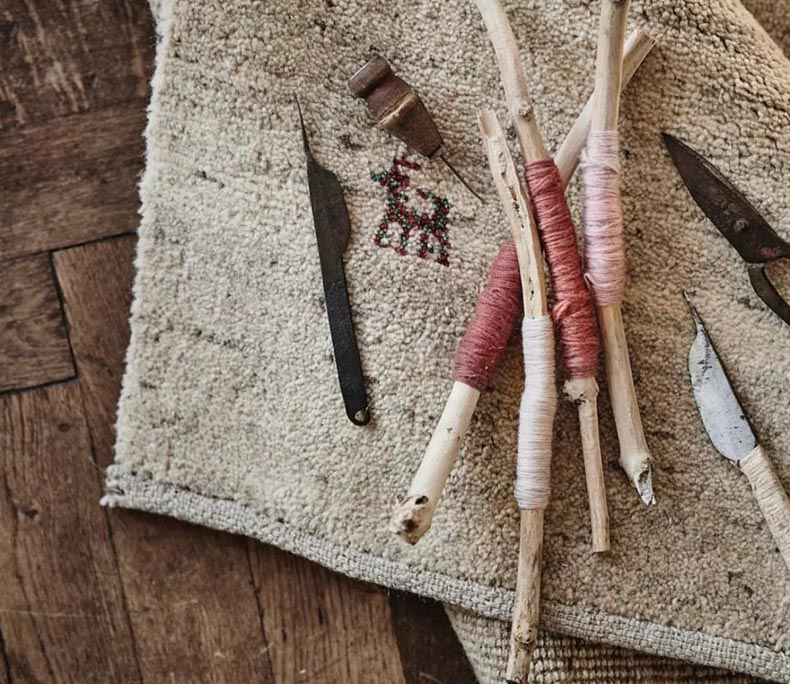What is carpet moth?
The carpet moth is a small butterfly with the scientific name “Tincola Biseliella”, it is yellow in color and its body length is 9-12 mm. The eggs of this insect become “larvae or baby moth” in one of their stages of development. The adult moth cannot damage the fibers of the handmade carpet, and the major damage is caused by the larvae, which feed on the protein in the wool for its growth.
The chemical structure of wool is keratin, that is, there are disulfide bonds between the chains, and the larvae break these bonds and eat the protein chains. In the next stage, the larvae turn into moths and after they mature, they lay eggs again. In this cycle, the number of larvae increases and the damage done to the carpet increases in a very short period of time.


Carpet Moth
It is interesting to know that one moth insect is able to destroy about 42 kg of wool after forty generations, and as a result, the destruction rate of the carpet also increases. The moth first eats the knots from the back of the carpet and starts its penetration into the handwoven carpet, and when they reach the warp of the carpet, they leave that area and then go to another area. Moths go to the carpet when the carpet is placed in a dark or damp place.
Certain types of moths are light in color and some are brown or gray in color. In general, there are two types of moths that damage wool: The first group of moths that chew clothes are called cloth moths and the second group of moths that chew carpets are called Beetles or carpet moths.
What does moth-eating mean?
Wherever there is moisture, there are different types of insects that attack the handwoven carpet. Termites, grasshoppers, crickets and moths are among these insects that feed on wool fibers and cause damage to it. Among these insects, moth is the most dangerous for wool carpets. This insect feeds on the protein in wool and can lay more than 100 eggs in a month. As mentioned in the introduction of moth, baby moth needs more protein to grow. As a result, it is able to eat the entire wool carpet in less than a year and leave only the cotton warps for you.


Carpet Moth, Life Cycle
How to get rid of carpet moths on wool carpets?
Handwoven carpets are a very valuable treasure. These carpets are made of natural fibers such as wool and silk, and for this reason, they are very vulnerable to external factors. If handwoven carpets are not properly taken care of, there may be no trace of the carpet left in a few months. Dirty wool fibers are a very suitable place for moths to live and grow. Therefore, if you have a valuable handmade carpet and you are looking to prevent its damage and moth-eaten; We recommend that you take the following measures to prevent carpet moth.
- Try to prevent the carpet from coming in contact with moisture. The best place to store handmade carpets is cool and moisture-free rooms with fresh air conditioning.
- Check the carpet or rug periodically and sweep them once a week. The creation of dust on the carpet can be one of the reasons for moth.
- Moth damage does not appear only in wet conditions. But the folds of the carpet or the parts that are placed under the furniture or the closet are also susceptible to moth-eating.
- Do not use a plastic cover to keep the carpet. You can use large cotton and fabric sheets to cover the carpet.
- Sweep the carpets that you don’t use before using them and spray them with carpet disinfectants. Then keep them rolled up in the warehouse.
- If you have naphthalene available, crush some tablets and place them on the carpet. Because naphthalene is very toxic, use proper gloves and mask when using it and be sure to keep it out of the reach of children. Also, instead of naphthalene, you can use anti-moth solutions available in the market to prevent moth.


Naphthalene
- Carpet moths have a strong sense of smell. They are attracted to the scent of fur, silk and wool. Apply tobacco powder, naphthalene or camphor on the back of the carpet, so that the smell that arises prevents moth from forming.


Tobacco
- Tableau rugs that are installed on the wall are easily damaged, so check the back of them from sometimes to prevent this from happening.


Carpet Moth
What are the causes of carpet moths?
Moisture
Moisture is not only the enemy of handmade carpets, but the enemy of any carpet. Moisture provides the conditions for the presence of all carpet-damaging insects. This factor not only provides the conditions for the growth of insects, but it can gradually cause the fibers and roots of your carpets to rot.
Insufficient light and ventilation
If you intend to store your carpets, keep them in places with good light and fresh air. Try to spread the carpet in the open air every few months and expose it to sunlight. Of course, avoid spreading the handmade carpet in front of the sun for a long time because it seriously damages its fibers.
Temperature
The temperature of the place where you place the carpet should be relatively cool to prevent the growth of fungi and vermin. If the air in the room is hot, it causes mildew and moth of handwoven carpets.
Getting the handwoven carpet dirty
Try to clean and wash your handmade carpets regularly. If for any reason the eggs of the moth bug are hidden among the fibers of the carpet, you can clean it quickly by sweeping. You should even do this for the back of the carpet because, as we said, the moth attacks from behind the carpet.
Not using anti-moth substances
Another factor that can cause handwoven carpets to rot is not to use anti-moth materials such as naphthalene or tobacco. Using these materials to a high percentage can prevent carpet moths.
Detection of carpet moth-eaten
Machine-made carpets, which are generally woven from synthetic fibers such as polyester and acrylic, and all-silk hand-woven carpets, if kept in proper conditions; They never get moth-eaten. But woolen handwoven carpets are vulnerable to moth-eating, if they are kept in the wrong place. These carpets are the only target of moths. If you see any of the following items in your handwoven carpet, suspect it of moth-eaten and use the methods that we mention in the rest of the article to eliminate it.
- In terms of structure, moth carpets have a butterfly-like appearance and are mostly seen in yellow color. This insect starts to penetrate into the hand-woven carpet from behind the carpet and eats the fibers at the end of the knots. This process continues until the pattern of the carpet disappears.
- Check the knots of the carpet from the back. If you see messy and chewed knots behind it, it is a reason of moth-eaten.


Moth-Eaten Turkmen Rug
- If you see very fine fibers on the carpet, it may be a sign of moth-eating on the wool.
- Small insects that move quickly on the carpet are an other sign of moth.
- As a result of theft, the knots of the carpet become very loose. If the fibers are torn while sweeping the carpet, it can be a reason for moth-eaten.
- Small insects on the carpet that move quickly.
- Seeing tiny gray eggs, which of course are not easy to identify.
What measures should we take to prevent the aggravation of moths in the carpet?
If you see the above symptoms, spread the carpet under direct sunlight or in very cold weather for several days in a row. The intense heat of the sun and very cold temperatures help to destroy the moth of the carpets. Another effective way to get rid of moths is to spray anti-moth poison. If you don’t know about the use of moth poison, it’s better not to do it and be sure to get help from experts.
A carpet that is torn should not be washed, but must first be delivered to a restorer so that the carpet can be repaired and then washed. Because if we wash the damaged carpet, there is a possibility that the whole carpet will tear because only the warps of the carpet are left and the wool has been eaten.
















One thought on “Expert Tips for Dealing with Moths and Beetles on Wool Carpets”